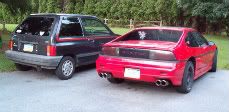Originally posted by FestYboy
View Post
Originally posted by FestYboy
View Post
As it is, the festiva bar is sort of a strange part. If it's allowed to move from side to side at all, the car does some really peculiar things. I realised this after Dragonhealer did the DIY poly sway bar bushings that were a popular mod awhile back. The car would pull to one side under throttle and pull the opposite way under braking. He changed out all sorts of other stuff (brake calipers, control arms, ect) to try and fix the issue, but it turned out to be those sway bar to frame bushings were allowing the bar to walk a little from side to side. This is more proof of the importance of maintaining the geometry of the front of these cars, and backs up the importance of the reinforced lower rad support on high hp cars.
Anyway, I'm now very cautious to do anything that would allow that bar to move side to side. As it is, it's kind of held in place by luck, since there is no thrust surface to limit the travel. It relies on the bends of the bar being squished by the bushing.

Comment